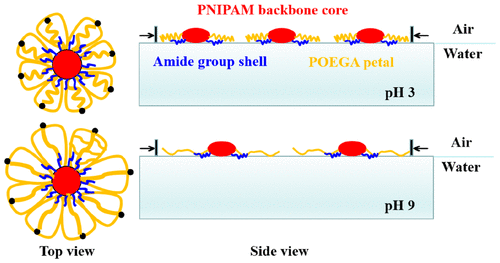当前位置:
X-MOL 学术
›
J. Phys. Chem. C
›
论文详情
Our official English website, www.x-mol.net, welcomes your
feedback! (Note: you will need to create a separate account there.)
Surface Micelle Structures and Monolayer Compression Moduli of Double Hydrophilic Block Copolymer
The Journal of Physical Chemistry C ( IF 3.3 ) Pub Date : 2020-07-13 , DOI: 10.1021/acs.jpcc.0c05272 Wenting Pan 1 , Hongxu Chen 1 , Gangyao Wen 1 , Despoina Giaouzi 2 , Stergios Pispas 2 , Jintao Zuo 1
The Journal of Physical Chemistry C ( IF 3.3 ) Pub Date : 2020-07-13 , DOI: 10.1021/acs.jpcc.0c05272 Wenting Pan 1 , Hongxu Chen 1 , Gangyao Wen 1 , Despoina Giaouzi 2 , Stergios Pispas 2 , Jintao Zuo 1
Affiliation

|
At the air/water interface, amphiphilic block copolymers are well-known to form typical surface micelles composed of hydrophobic block cores and hydrophilic block coronas. However, the micelle/aggregate structures of the double hydrophilic block copolymers (DHBCs) need to be explored because of the lack of hydrophobic blocks. Influences of subphase pH and temperature on the interfacial aggregation behavior of a thermoresponsive DHBC of poly(N-isopropylacrylamide)-block-poly[oligo(ethylene glycol) acrylate] (PNIPAM-b-POEGA) and the structures of its Langmuir–Blodgett (LB) films were studied with the Langmuir monolayer technique and atomic force microscopy, respectively. All initial LB films of PNIPAM-b-POEGA show circular micelles with a sunflower-like structure composed of a small PNIPAM backbone core, a short amide group shell, and several large POEGA petals, the structure of which is proposed in the DHBCs for the first time. Two kinds of novel methods based on the methylene group number in a core or the core diameter were successfully used to evaluate the micelle structure. With the increase of subphase pH, the isotherms move toward the larger mean molecular areas due to the gradually increased stretching degrees of POEGA blocks at the air/water interface. With the rise in temperature, the limiting molecular areas of the isotherms initially increase and then decrease above the lower critical solution temperature. As compared to those of other copolymers, the maximum monolayer compression moduli of PNIPAM-b-POEGA are very low, which indicates that the DHBC monolayers are highly compressible. Furthermore, at low temperature, hysteresis levels in the continuous compression–expansion cycles decrease stage by stage, whereas those at high temperature change slightly.
中文翻译:

双亲水嵌段共聚物的表面胶束结构和单层压缩模量
在空气/水界面处,两亲性嵌段共聚物形成由疏水性嵌段核和亲水性嵌段电晕组成的典型表面胶束是众所周知的。然而,由于缺乏疏水性嵌段,需要研究双亲水性嵌段共聚物(DHBC)的胶束/聚集体结构。副相pH和温度上的聚热响应DHBC(的界面聚集行为的影响Ñ -isopropylacrylamide) -嵌段-聚[低聚(乙二醇)丙烯酸酯](PNIPAM- b -POEGA)及其朗缪尔-布洛杰特的结构( LB)膜分别用Langmuir单层技术和原子力显微镜研究。PNIPAM- b的所有初始LB电影-POEGA显示出圆形的胶束,其具有向日葵样结构,由小的PNIPAM主链核心,短的酰胺基壳和几个大的POEGA花瓣组成,其结构首次在DHBC中提出。基于核中亚甲基数或核直径的两种新方法已成功用于评估胶束结构。随着子相pH值的增加,由于POEGA嵌段在空气/水界面处的拉伸程度逐渐增加,等温线向较大的平均分子区域移动。随着温度的升高,等温线的极限分子面积首先增加,然后在较低的临界溶液温度以下降低。与其他共聚物相比,PNIPAM- b的最大单层压缩模量-POEGA非常低,这表明DHBC单层是高度可压缩的。此外,在低温下,连续压缩-膨胀循环中的磁滞水平会逐步降低,而在高温下的磁滞水平会略有变化。
更新日期:2020-08-06
中文翻译:

双亲水嵌段共聚物的表面胶束结构和单层压缩模量
在空气/水界面处,两亲性嵌段共聚物形成由疏水性嵌段核和亲水性嵌段电晕组成的典型表面胶束是众所周知的。然而,由于缺乏疏水性嵌段,需要研究双亲水性嵌段共聚物(DHBC)的胶束/聚集体结构。副相pH和温度上的聚热响应DHBC(的界面聚集行为的影响Ñ -isopropylacrylamide) -嵌段-聚[低聚(乙二醇)丙烯酸酯](PNIPAM- b -POEGA)及其朗缪尔-布洛杰特的结构( LB)膜分别用Langmuir单层技术和原子力显微镜研究。PNIPAM- b的所有初始LB电影-POEGA显示出圆形的胶束,其具有向日葵样结构,由小的PNIPAM主链核心,短的酰胺基壳和几个大的POEGA花瓣组成,其结构首次在DHBC中提出。基于核中亚甲基数或核直径的两种新方法已成功用于评估胶束结构。随着子相pH值的增加,由于POEGA嵌段在空气/水界面处的拉伸程度逐渐增加,等温线向较大的平均分子区域移动。随着温度的升高,等温线的极限分子面积首先增加,然后在较低的临界溶液温度以下降低。与其他共聚物相比,PNIPAM- b的最大单层压缩模量-POEGA非常低,这表明DHBC单层是高度可压缩的。此外,在低温下,连续压缩-膨胀循环中的磁滞水平会逐步降低,而在高温下的磁滞水平会略有变化。































 京公网安备 11010802027423号
京公网安备 11010802027423号